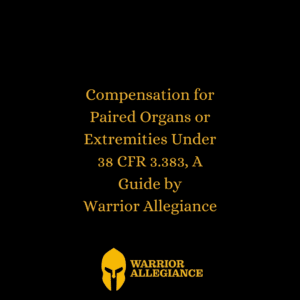
As veterans bravely serve their country, they often encounter injuries and disabilities that impact their lives long after their service has ended. At Warrior Allegiance, our primary focus is on assisting veterans with their disability compensation claims through evidence-based, fact-finding proven methods. Today, we delve into the complexities of compensation for paired organs or extremities under 38 CFR 3.383, providing veterans with the guidance and assistance they need to navigate this intricate process.
What is Compensation for Paired Organs or Extremities?
Compensation under 38 U.S.C. 1160 is available for disabilities involving certain paired organs or extremities, where one is service-connected (SC) and the other is non-service-connected (NSC). This compensation is provided the NSC disability is not due to the veteran’s own willful misconduct.
Criteria for Establishing Entitlement
To establish entitlement to compensation for paired organs or extremities, certain criteria must be met. These include impairments such as vision loss, kidney involvement, deafness, loss or loss of use of extremities, and lung disabilities. At Warrior Allegiance, we guide veterans through the process of meeting these criteria, ensuring they have the necessary evidence to support their claims.
Understanding Effective Dates
Effective dates for the provisions of the law that created the criteria for compensation under 38 U.S.C. 1160 vary depending on the specific disability. For instance, impairment of vision in one eye due to an SC disability and impairment in the other eye due to an NSC disability became effective on different dates. Similarly, dates vary for other disabilities such as kidney involvement, deafness, loss of extremities, and lung disabilities. Warrior Allegiance helps veterans understand these effective dates and how they impact their claims.
Eligibility for Other Benefits
Entitlement to compensation under 38 U.S.C. 1160 also creates eligibility for other benefits, including Dependency and Indemnity Compensation (DIC) and Dependents’ Educational Assistance (DEA) under 38 U.S.C. Chapter 35. However, it’s essential to note that compensation under this provision does not create entitlement to other benefits such as special allowances or specially adapted housing.
Navigating the Process with Warrior Allegiance
Navigating the complexities of compensation for paired organs or extremities can be overwhelming for veterans. At Warrior Allegiance, we provide veterans with the assistance and support they need throughout the entire claims process. From gathering evidence to submitting claims and appealing decisions, our team is dedicated to ensuring veterans receive the compensation and benefits they rightfully deserve.
Conclusion
At Warrior Allegiance, we stand alongside veterans as they navigate the intricacies of disability compensation claims. Through evidence-based methods and expert guidance, we help veterans understand and access the compensation they’re entitled to for paired organs or extremities. If you’re a veteran in need of assistance with your disability compensation claims, don’t hesitate to reach out to Warrior Allegiance today. Your service to our country deserves recognition and support, and we’re here to provide it every step of the way.
https://warriorallegiance.com/fbgetstarted/

